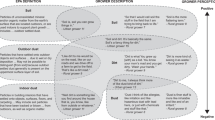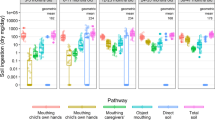Abstract
Marine oil spills and the resulting environmental contamination is common along coastal areas; however, information is lacking about the safety of impacted beaches for public use, especially for the most vulnerable population: children. One route of exposure for children at oil impacted beaches is through contact with sands. The purpose of this study was to evaluate beach sand skin adherence for children under the age of seven. Each of 122 children participated in a hand press trial conducted at one of four different U.S. beaches (two in Miami, FL, and two in Galveston, TX USA). During the hand press trials, hand conditions of the children were randomized (dry, wet, or with sunscreen), and soil adherence (mass of sand per palmar surface area of the hand) and the maximum pressure applied (force applied per area of hand) was measured and calculated. Each child was instructed to press their hands on a soil laden tray for 5 s and pressure of contact was measured using a scale. Results (n = 98) showed that the average soil adherence for both palmar hands across the four beaches ranged from 0.200 to 234 mg/cm2 with an average of 35.7 mg/cm2, with boys (40.4 mg/cm2) showing slightly higher means than girls (31.7 mg/cm2), but these differences were not significant even after adjusting for age. Among the three conditions evaluated, the highest loading was measured for children with wet hands (mean 65.3 mg/cm2), followed by dry hands (mean 24.5 mg/cm2). Sunscreen hands (mean 23.2 mg/cm2) had the lowest loadings. The pressure of contact ranged from 0.180 to 1.69 psi and varied by age groups and by height and weight, where pressure of contact did not have a significant influence on soil adherence. The average adhered sand grain size and average ambient sand grain size both had a statistically significant impact on hand soil adherence. Overall results from this study can be utilized in exposure and risk assessment models to evaluate the possible health impacts from contaminants found in beach sands.
This is a preview of subscription content, access via your institution
Access options
Subscribe to this journal
Receive 6 print issues and online access
$259.00 per year
only $43.17 per issue
Buy this article
- Purchase on Springer Link
- Instant access to full article PDF
Prices may be subject to local taxes which are calculated during checkout




Similar content being viewed by others
Change history
02 December 2020
The original HTML version of this Article was updated to correct an error in the acknowledgements section. The error concerned access to the dataset. The dataset should be ‘R6.x828.000:0005’ - there was previously a “.” Missing after the R6.
References
Ferguson A, Del Donno C, Obeng-Gyasi E, Mena K, Kaur Altomare T, Guerrero R, et al. Children exposure-related behavior patterns and risk perception associated with recreational beach use. Int J Environ Res Public Health. 2019a;16:2783.
Black J, Welday J, Buckley B, Ferguson A, Gurian P, Mena K, et al. Risk assessment for children exposed to beach sands impacted by oil spill chemicals. Int J Environ Res Public Health. 2016;13:853.
Sabino R, Rodriques R, Carneiro C, Cunha M, Duate A, Faria N, et al. Routine public screening of harmful microorganism in beach sands: Implication to public health. Sci Total Environ. 2014;15:1062–9.
Weiskerger CJ, Brandão J, Ahmed W, Aslan A, Avolio L, Badgley B, et al. Impacts of a changing earth on microbial dynamics and human health risks in the continuum between beach water and sand. Water Res. 2019;162:456–70.
Shibata T, Solo-Gabriele HM. Quantitative microbial risk assessment of human illness from exposure to marine beach sand. Environ Sci Technol. 2012;46:2799–805. https://doi.org/10.1021/es203638x.
Ruby M, Lowney Y, Bunge A, Roberts S, Gomez-Eyles J, Ghosh U, et al. Oral bioavailability, bioaccessibility, and dermal absorption of PAHs from soil—State of the science. Environ Sci Technol. 2016;50:2151–64.
Ferguson A, Canales R Leckie A. “Dermal exposure and dose,” exposure analysis, Eds. Ott W, Wallace L, and Steinman A, Taylor & Francis Group, CRC Press, Boca Raton, Catalog #L1663; 2006. https://www.taylorfrancis.com/books/9780429138942.
Tomenchok L, Gidley ML, Mena KD, Ferguson AC, Solo-Gabriele H. Children’s abrasions in recreational beach areas and a review of possible wound infections. Int J Environ Res Public Health. 2020;17:4060. https://doi.org/10.3390/ijerph17114060.
Hsi H, Hu C, Tsou M, Hu H, Ozkaynak H, Bradham K, et al. Determination of hand soil loading, soil, and particle size variations after hand-pressing and hand-mouthing activities. Sci Total Environ. 2018;627:844–51.
Moya J, Phillips L. A review of soil and dust ingestion studies for children. J Exposure Sci Environ Epidemiol. 2014;24:545–54.
Ruby M, Lowney Y. Selective soil particle adherence to hands: Implications for understanding oral exposure to soil contaminants. Environ Sci Technol. 2012;46:12759–71.
Cohen HubalE, Sheldon L, Burke J, McCurdy T, Berry M, Rigas M, et al. Children’s exposure assessment: a review of factors influencing children’s exposure, and the data available to characterize and assess that exposure. Environ Health Perspect. 2000;108:475–85.
Ferguson A, Black J, Sims I, Welday J, Elmir S, Goff E, et al. Risk assessment for children exposed to arsenic on baseball fields with contaminated fill material. Int J Environ Res Public Health. 2018;4:E67. https://doi.org/10.3390/ijerph15010067.
Spalt E, Kissel J, Shirai J, Bunge A. Dermal absorption of environmental contaminants. J Exposure Sci Environ Epidemiol. 2009;19:119–1948.
Kissel J, Richter K, Fenske R. Field transfer measurement of dermal soil loading attributable to various activities: implications for exposure assessment. Risk Anal. 1996;16:115–25.
Ferguson A, Dwivedi AK, Ehindero E, Adelabu F, Rattler K, Perone H, et al. Soil hand and body adherence measures across four beach areas: potential influence on exposure to oil spill chemicals. Int J Environ Res Public Health. 2020;17:4196. https://doi.org/10.3390/ijerph17124196.
Shoaf M, Shirai J, Kedan G, Schaum J, Kissel J. Child dermal sediment loads following play in a flat tide. J Exposure Anal Environ Epidemiol. 2005;15:407–12.
Ferguson A, Bursac Z, Coleman S, Biddle D, Johnson W. Comparisons of computer controlled chamber measurements for soil-skin adherence from aluminum and carpet surfaces. Environ Res. 2009a;109:207–14.
Ferguson A, Coleman S, Biddle D, Bursac Z, Johnson W. In-vitro soil adherence for dermal exposure using a controlled mechanical chamber. J Appl Sci Res. 2009b;5:232–43.
Ferguson A, Bursac Z, Johnson W, Davis J. Computer-controlled chamber measurements for clay adherence relevant for potential exposure through skin. J Environ Sci Health. 2012;47:382–8. Part A
Ferguson A, Bursac Z, Johnson W, Davis J. Combined analysis of results on single and multiple contacts: potting soil, sand and clay transfers to cloth for the estimate of soil adherence to human Skin. Environ Nat Resour Res. 2013;3:33–44.
Bergstrom C. Particle Size distributions, size concentration relationships, and adherence to hands of selected geologic media derived from mining, smelting, and quarrying activities. Sci Total Environ. 2011;409:4247–56.
Cao Z, Yu G, Chen Y, Fiedler H, Deng S. Particle size: a missing factor in risk assessment of human exposure to toxic chemical in settled indoor dust. Environ Int. 2012;49:24–30.
Juhasz A, Weber J, Smith E. Impact of soil particle size and bioaccessibility on children and adult lead exposure in peri-urban contaminated soils. J Hazard Mater. 2011;186:1870–9.
Lee SH, Jeong SK, Ahn SK. An update of the defensive barrier function of skin. Yonsei Med J. 2006;47:293–306. https://doi.org/10.3349/ymj.2006.47.3.293.
Wan H, Dopping-Hepenstal P, Gratian M, Stone M, McGrath J, Eady R. Desmosomes exhibit site-specific features in human palm skin. Exp Dermatol. 2003;12:378–388. https://doi.org/10.1034/j.1600-0625.2002.120404.x.
Finley B, Scott P, Mayhall D. Development of a standard soil‐to‐skin adherence probability density function for use in monte carlo analyses of dermal exposure. Risk Anal. 1994;14:555–69.
U.S. Environmental Protection Agency (EPA). Exposure Factors Handbook 2011 Edition (Final Report). Washington, DC: U.S. Environmental Protection Agency, EPA/600/R-09/052F; 2011.
Tsou M, Hu C, His H, Hu H, Ozkaynak H, Hseu Z, et al. Soil-to-skin adherence during different activities for children in Taiwan. Environ Res. 2018;167:240–7.
Ferguson A, Mena Kristina, Solo-Gabriele H. Assessment for oil spill chemicals: current knowledge, data gaps, and uncertainties in addressing human physical health risk. Mar Pollut Bull. 2019b;150. https://doi.org/10.1016/j.marpolbul.2019.110746.
Perone H, Rattler K, Ferguson AC, Mena KD, Solo-Gabriele HM. Review of methods to determine hand surface area of children less than six years old: a case study. Environ Geochem Health. 2020. https://doi.org/10.1007/s10653-020-00699-9.
Young A, Greenaway J, Harrison G, Lawrence K, Sarkany R, Douki T, et al. Sub-optimal application of a high SPF sunscreen prevents epidermal damage in vivo. Act Derm Vernereol. 2018;98:880–7.
Choate L, Ranville J, Bunge A, Macalady D. Dermally adhered soil: 2. Reconstruction of dry-sieve particle size distribution from wet-sieve data. Integr Environ Assess Manag. 2006;2:385–90.
Gelman A. Analysis of variance—why it is more important than ever. Ann Stat. 2005;33:1–53.
Ehlers L, Luthy R. Contaminant bioavailability in soil and sediment. Environ Sci Technol. 2003;37:295A–302A. https://doi.org/10.1021/es032524f.
Beamer P, Elish C, Roe D, Loh M, Layton D. J Environ Monit. 2012;14:839–44.
Black JC, Welday JN, Buckley B, Ferguson A, Gurian PL, Mena KD, et al. Risk assessment for children exposed to beach sands impacted by oil spill chemicals. Int J Environ Res Public Health. 2016;13:853. https://doi.org/10.3390/ijerph13090853.
Kissel J, Shirai J, Richter K, Fenske R. Investigation of dermal contact with soil in controlled trials. J Soil Contam. 1998;7:737–52.
Acknowledgements
This research was made possible by a grant from The Gulf of Mexico Research Initiative (GoMRI) (#G231817). Data are publicly available through the Gulf of Mexico Research Initiative Information & Data Cooperative (GRIIDC) at https://data.gulfresearchinitiative.org (dataset: R6.x828.000:0005). This work was part of the GoMRI project called “BEACHES” which focused on evaluating children exposures to oil spill contaminants. BEACHES also involved surveys, videotaping, oil fate and transport estimates, and risk assessment. Thanks to all of the students, community members, and researchers from the Miami and Galveston areas, and universities. Students who participated were funded through multiple university initiatives and programs. We also appreciate the access to the Microtrac Particle Size Analyzer which was made possible by the Collaborative Laboratory of the University of Miami College of Engineering and Johnson and Johnson 3D Printing Center of Excellence.
Author information
Authors and Affiliations
Corresponding author
Ethics declarations
Conflict of interest
The authors declare that they have no conflict of interest.
Additional information
Publisher’s note Springer Nature remains neutral with regard to jurisdictional claims in published maps and institutional affiliations.
Supplementary information
Rights and permissions
About this article
Cite this article
Ferguson, A., Rattler, K., Perone, H. et al. Soil–skin adherence measures from hand press trials in a Gulf study of exposures. J Expo Sci Environ Epidemiol 31, 158–169 (2021). https://doi.org/10.1038/s41370-020-00269-2
Received:
Revised:
Accepted:
Published:
Issue Date:
DOI: https://doi.org/10.1038/s41370-020-00269-2
Keywords
This article is cited by
-
A systematic characterization of soil/dust ingestion for typical subpopulations in China
Environmental Geochemistry and Health (2023)



